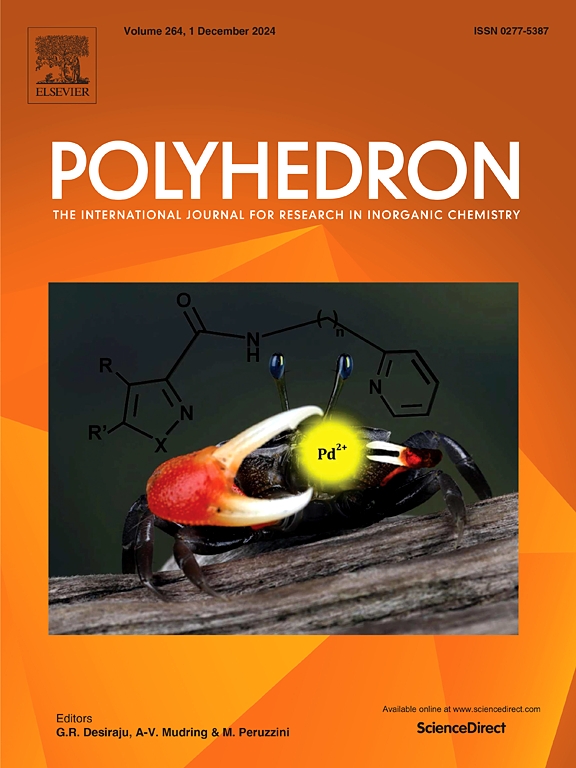磷灰石磷酸三钙粉Ca9(HPO4)(PO4)5(OH)是一种绿色合成3,4-二氢吡喃[c]铬和四氢苯并[b]吡喃衍生物的有效催化剂
IF 2.4
3区 化学
Q2 CHEMISTRY, INORGANIC & NUCLEAR
引用次数: 0
摘要
本研究深入评估了Ca9(HPO4)(PO4)5(OH)在吡喃衍生物可持续合成中的催化效果。采用傅里叶变换红外光谱(FT-IR)、扫描电镜(SEM)、能量色散x射线分析(EDAX)、元素映射和x射线衍射(XRD)等分析技术对Ca9(HPO4)(PO4)5(OH)进行了表征。在最佳反应条件下,Ca9(HPO4)(PO4)5(OH)催化剂通过丙二腈、4-羟基香豆素或二美酮与芳香醛三组分之间的多组分缩合反应,催化合成3,4-二氢吡喃[c]铬和四氢苯并[b]吡喃衍生物表现出显著的效率。除了红外光谱外,这些衍生物还可以通过质子和碳核磁共振来识别。这种方法有几个优点,包括简单的净化,在相对较短的时间内以良好到优异的产量获得所需的产品,并且可以重复使用催化剂多达五次而不会有任何明显的效率损失。本文章由计算机程序翻译,如有差异,请以英文原文为准。
![Apatite tricalcium phosphate powder Ca9(HPO4)(PO4)5(OH) is an effective and eco-friendly catalyst for the green synthesis of 3,4-dihydropyrano[c]chromenes and tetrahydrobenzo[b]pyrans derivatives](https://img.booksci.cn/booksciimg/2025-4/102303286501776764606.jpg)
Apatite tricalcium phosphate powder Ca9(HPO4)(PO4)5(OH) is an effective and eco-friendly catalyst for the green synthesis of 3,4-dihydropyrano[c]chromenes and tetrahydrobenzo[b]pyrans derivatives
This research investigation presents an in-depth assessment of the catalytic efficacy of Ca9(HPO4)(PO4)5(OH) in the context of sustainable pyran derivative synthesis. The characterization of Ca9(HPO4)(PO4)5(OH) was conducted using a range of analytical techniques, including Fourier-transform infrared spectroscopy (FT-IR), scanning electron microscopy (SEM), energy dispersive X-ray analysis (EDAX), elemental mapping, and X-ray diffraction (XRD). The Ca9(HPO4)(PO4)5(OH) catalyst exhibited noteworthy efficiency in catalyzing the synthesis of 3,4-dihydropyrano[c]chromenes and tetrahydrobenzo[b]pyrans derivatives by multicomponent condensation via the reaction between three components: malononitrile, 4-hydroxycoumarin or dimedone and aromatic aldehydes, under optimum reaction conditions. In addition to infrared spectroscopy, these derivatives are identified by proton and carbon nuclear magnetic resonance. This approach offers several advantages, including simple purification, obtaining the desired products in good to excellent yields and in a relatively short time, and the possibility of reusing the catalyst up to five times without any significant loss of efficiency.
求助全文
通过发布文献求助,成功后即可免费获取论文全文。
去求助
来源期刊

Polyhedron
化学-晶体学
CiteScore
4.90
自引率
7.70%
发文量
515
审稿时长
2 months
期刊介绍:
Polyhedron publishes original, fundamental, experimental and theoretical work of the highest quality in all the major areas of inorganic chemistry. This includes synthetic chemistry, coordination chemistry, organometallic chemistry, bioinorganic chemistry, and solid-state and materials chemistry.
Papers should be significant pieces of work, and all new compounds must be appropriately characterized. The inclusion of single-crystal X-ray structural data is strongly encouraged, but papers reporting only the X-ray structure determination of a single compound will usually not be considered. Papers on solid-state or materials chemistry will be expected to have a significant molecular chemistry component (such as the synthesis and characterization of the molecular precursors and/or a systematic study of the use of different precursors or reaction conditions) or demonstrate a cutting-edge application (for example inorganic materials for energy applications). Papers dealing only with stability constants are not considered.
 求助内容:
求助内容: 应助结果提醒方式:
应助结果提醒方式:


